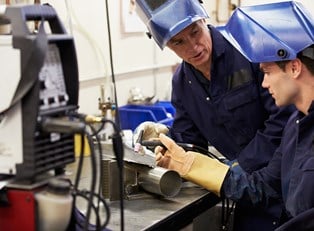Welding can be a fun and exciting career, but it takes a certain level of skill and mastery of different welding techniques. If you’re looking to make a career out of welding, you should be familiar with the different types of welding. Although there are hundreds of welding techniques, these five are the most commonly used by welders in all kinds of industries. Learn about each technique for a better understanding of what welders do and what kinds of tools and materials they work with.
Shield Metal Arc Welding
Shield Metal Arc Welding (SMAW) is the world’s leading welding technique. Using an electric current power tool, welders form an electric arc between the power source and the materials that are being joined. When using SMAW, the electric current is coated in flux, which disintegrates and provides a layer of slag as the weld is being laid. This layer of slag then protects the weld. This method is a relatively simplistic welding method, but it also gives off a relatively high wastage of metal.
Gas Tungsten Arc Welding
Gas Tungsten Arc Welding (GTAW) is a commonly used welding technique when welding thinner materials like stainless steel, aluminum, or copper alloys. Tungsten is a natural chemical element that is used in this method to produce a similar arc as the SMAW method. The GTAW method is a fairly slow and complicated method, so it is much less popular than the SMAW method.
Gas Metal Arc Welding
Gas Metal Arc Welding (GMAW) is a technique that creates an arc between the material and an electric wire to melt the material being welded. This method is commonly used for materials such as steel and aluminum. This method is commonly used within industry settings because it simple and easy to transfer to automatic welding techniques.
Flux-Cored Arc Welding
Commonly used for construction welding, the Flux-Cored Arc Welding (FCAW) technique uses a consumable electrode containing flux to produce a shielding gas and liquid slag. This method is flexible and portable, hence its widespread use in construction industries. Some methods of FCAW also do not require a shielding gas, which makes it easier to use outdoors and in less-than-ideal weather conditions.
Submerged Arc Welding
The Submerged Arc Welding (SAW) technique works by forming a blanket of chemicals over the welded area to protect it from environmental deterioration. This method is only used on steel metals and nickel-based alloys, but enables the welder to make quick, deep-welded penetrations into the materials being welded.



